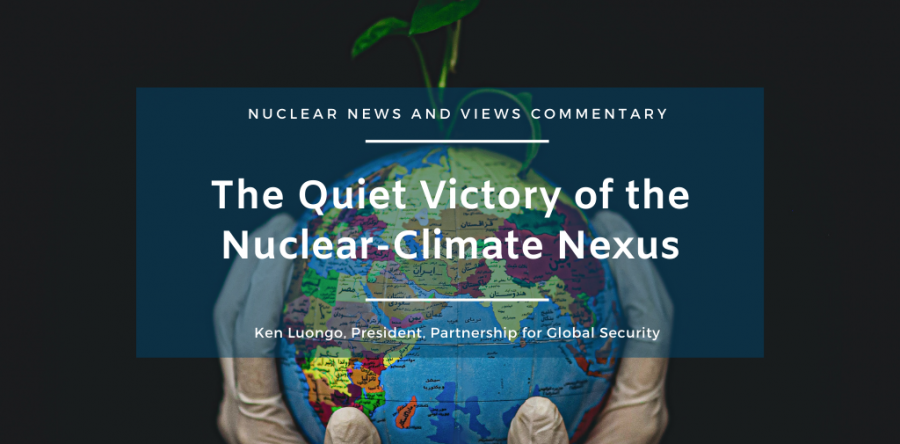The hot air machine at the Glasgow climate conference has mercifully been shut off after running on overdrive for two weeks. In its wake one of the quietest but most significant achievements was the elevation of the nuclear-climate nexus.
The challenge in this victory is to quickly and effectively pivot from the prior quest for nuclear-climate validation to a next-phase strategy supporting the timely, cost effective, and secure delivery of new nuclear capacity.
This outcome was driven by a shift in elite opinion and the realization of a growing number of governments that running industrial and growing economies primarily on intermittent power sources is increasingly dicey.
The opinion shift on the nuclear-climate nexus was evident across the political spectrum.
The chairwoman of the editorial board of the Financial Times stated that she had a rude awakening regarding her hope for a renewable energy response to climate change. “We either need to hope for a miracle around battery storage or hedge our bets with backup sources, such as nuclear.”
That stalwart of the establishment, The Economist magazine, wrote that nuclear power made, “fighting climate change a lot easier.”
The progressive The American Prospect magazine noted that nuclear energy was being treated like a “pariah” by the participants in the climate conference. This despite the fact that, “nuclear energy has gained new respect, due primarily to wind and solar’s energy storage and intermittency issues.”
Also on the American left, The Atlantic referred to nuclear power as, “the Atlas of carbon-free energy production, keeping the world hefted on its shoulders.”
Not to be left out, the right-of-center Wall Street Journal published an opinion piece that blankly stated, “Either for ideology or profit, climate activists promote wind and solar solutions despite the enormous carbon footprint to manufacture them, their intermittent energy production, and the monstrous cost and pollution required to manufacture and dispose of batteries for green backup. But the single greatest sin is the demonization of nuclear power.”
A number of the core nuclear-climate nexus arguments were underscored in a package of articles in Foreign Affairs titled, “Going Nuclear on Climate Change.” This set was a response to a previous article published in the journal by a former chairperson of the U.S. Nuclear Regulatory Commission. It complained about the inability of nuclear power to respond to the climate crisis fast and cheaply enough.
One of the Foreign Affair’s “Going Nuclear” authors captured the true essence of this objection by explaining that nuclear energy is clearly opposed by a strain of environmental elites. But that opposition is cloaked by deflection that expresses itself as disappointment about high costs and construction timeliness.
This author noted that, “the only thing more costly than trying to build out a zero-carbon grid with nuclear energy…is trying to build out a zero-carbon grid without nuclear energy.”
Interestingly, the former NRC chairperson, in a recent interview, agreed that there was a pressing need to move away from fossil fuels quickly, and that “nuclear would be a part of that mix, potentially, if we were really, really serious,” adding that “it means a lot of money.”
Major industrial nations seem to have arrived at that same conclusion.
Japan, South Korea, France, the U.K., Brazil, Russia, China, the U.S., and the leadership of the European Union all endorsed the role of nuclear energy in reducing carbon emissions at or around the COP.
There also were announcements in Glasgow about U.S. support for new nuclear energy development and collaborations with Poland, Kenya, Ukraine, Brazil, Indonesia, and Romania. The American bipartisan infrastructure bill that was signed this week by the president has significant funding for existing nuclear plants and next-generation reactor development.
Even the U.N. got on board. The Director General of the IAEA noted that at COP25 in Madrid, he was advised that nuclear was unwelcome. In Glasgow he anchored a high-impact discussion of the nuclear-climate intersection.
In concert with the IAEA, the United Nations Economic Commission for Europe published “Key Takeaways” for how existing and future nuclear energy can support “climate and sustainable development objectives.”
This wave of nuclear-climate nexus validation is important and reflects a sober realism and recalibration of how the globe most effectively decarbonizes.
The challenge for the emerging generation of smaller nuclear technologies in this new environment is the need to deliver in a timely fashion. This is particularly important in democratic nations where new technology programs can become endless R&D efforts.
What these nations need is a realistic, actionable, and collaborative strategy for the development, licensing, and deployment at scale of these new nuclear technologies. This roadmap is essential for avoiding technical cul-de-sacs, ensuring effective non-proliferation and security, and circumventing circular firing squads in pursuit of market share.
The fact that this strategy doesn’t exist provides succor to the nuclear opponents that are patiently anticipating the meltdown of these future nuclear technologies.
The unfortunate flip side is that their opposition won’t stop nuclear energy from being deployed. Instead, it will allow Russia and China to control the global nuclear market for the remainder of this century. That will be a tragedy for global security. And that is really, really serious.
Ken Luongo, President, Partnership for Global Security


